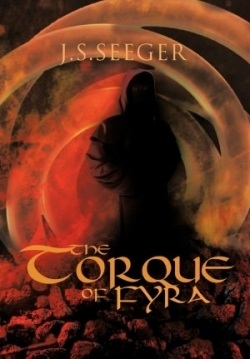The Torque of Frya
In Laurasia, the gods are gone. Three hundred years ago, the four elemental gods were banished by the ruler of the cosmos after dooming the realm to chaos in an attempt to dominate one another. The gods left behind four great totems, artifacts with the power to decide the fate of the world. Among these was the Torque of Fyra. Now, this divine tool has found its way into the hands of Jarok of Kernia, a young adventurer.
Jarok joins Vadera, an elven enchantress, on a journey to deliver the torque to a wizard. Meanwhile, war ravages Jarok’s homeland, as the necromancer Xorphuricx brings armies of men and monsters to bear against Kernia. When Jarok and Vadera meet the wizard Lexor, they discover that Jarok is heir to the dragon bond—the bloodline that will allow mankind to reforge an alliance with the dragons.
As the kingdom of Kernia comes under siege, Jarok and Vadera set out to seek help from the dragons. Though the defense of Kernia ends in success, the novel ends with the clear implication of a sequel: the kingdom is safe, but a threat that transcends the mortal plane of existence is still at large.
The Torque of Fyra has all the trappings of enjoyable, if derivative, fantasy, but it is emphatically not enjoyable. J.S. Seeger is a published poet, and this is his first novel. On the level of plotting and structure, the book is serviceable at best; at the level of words and sentences, it is often painful to read. The text is rife with inexcusable errors. At one point in the novel, artifacts previously referred to as “grueling stones” suddenly become “sapen stones” without explanation. Even if one graciously ignores the editorial oversights, Seeger’s prose is overwrought. Here is how he describes Jarok’s meeting with Agatha, an aged elf: “As Jarok looked upon her, he felt her probing discernment as though she was peering into his soul.”
Seeger seems to be trying far too hard to give his book the feel of a work by J. R. R. Tolkien by co-opting the descriptive style and high diction of the author. Yet in focusing on grandiosity, Seeger neglects his characters. Readers will be hard-pressed to recall one interesting thing about either of the lead characters, let alone the supporting cast. Inevitably, Jarok and Vadera fall in love, and their relationship climaxes with Vadera exclaiming: “Take me Jarok—take me and be mine forever.”
The book shows promise when Seeger gets creative with Laurasia’s mythology. For instance, when Jarok and Vadera arrive at a desert spring, they find it to be perfectly, unnaturally calm. The mirror-still surface of the water is Seeger’s subtle hint at the presence of a minor goddess. Unfortunately, such moments of effective atmosphere are few and far between.
The Torque of Fyra would have benefited from much more attention from an editor and a great deal more thought from its author.
Reviewed by
Kenrick Vezina
Disclosure: This article is not an endorsement, but a review. The publisher of this book provided free copies of the book and paid a small fee to have their book reviewed by a professional reviewer. Foreword Reviews and Clarion Reviews make no guarantee that the publisher will receive a positive review. Foreword Magazine, Inc. is disclosing this in accordance with the Federal Trade Commission’s 16 CFR, Part 255.

